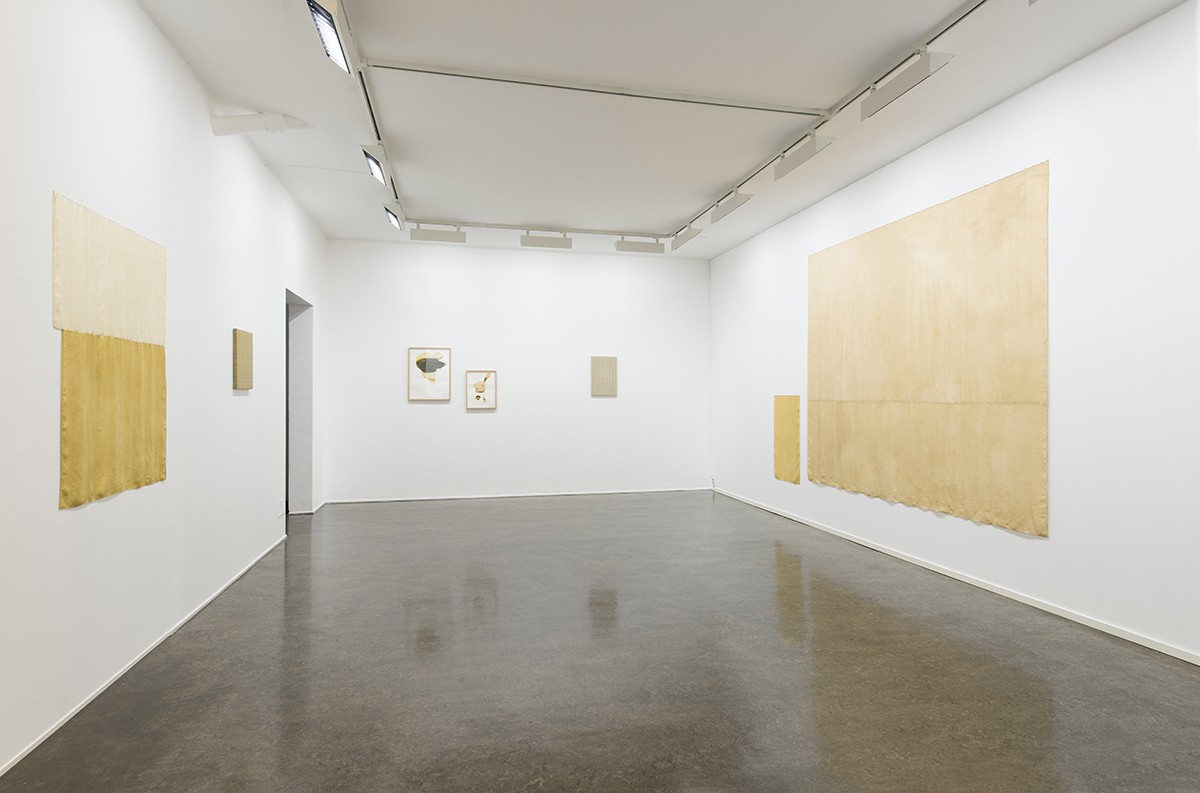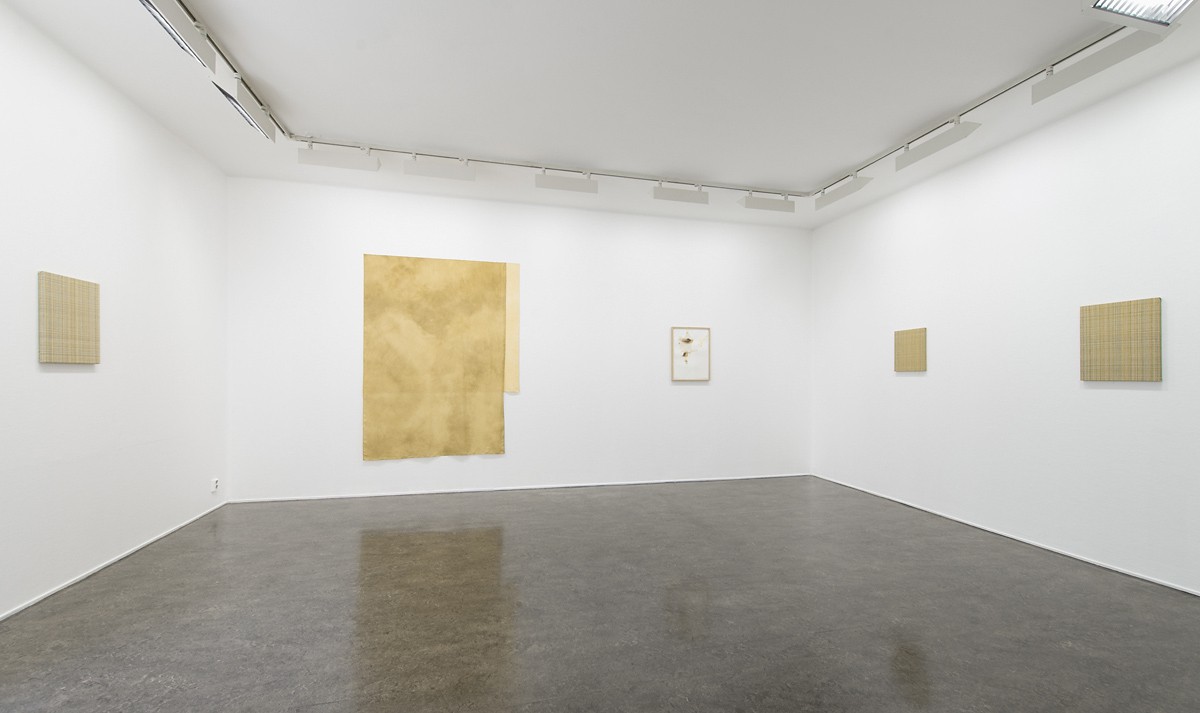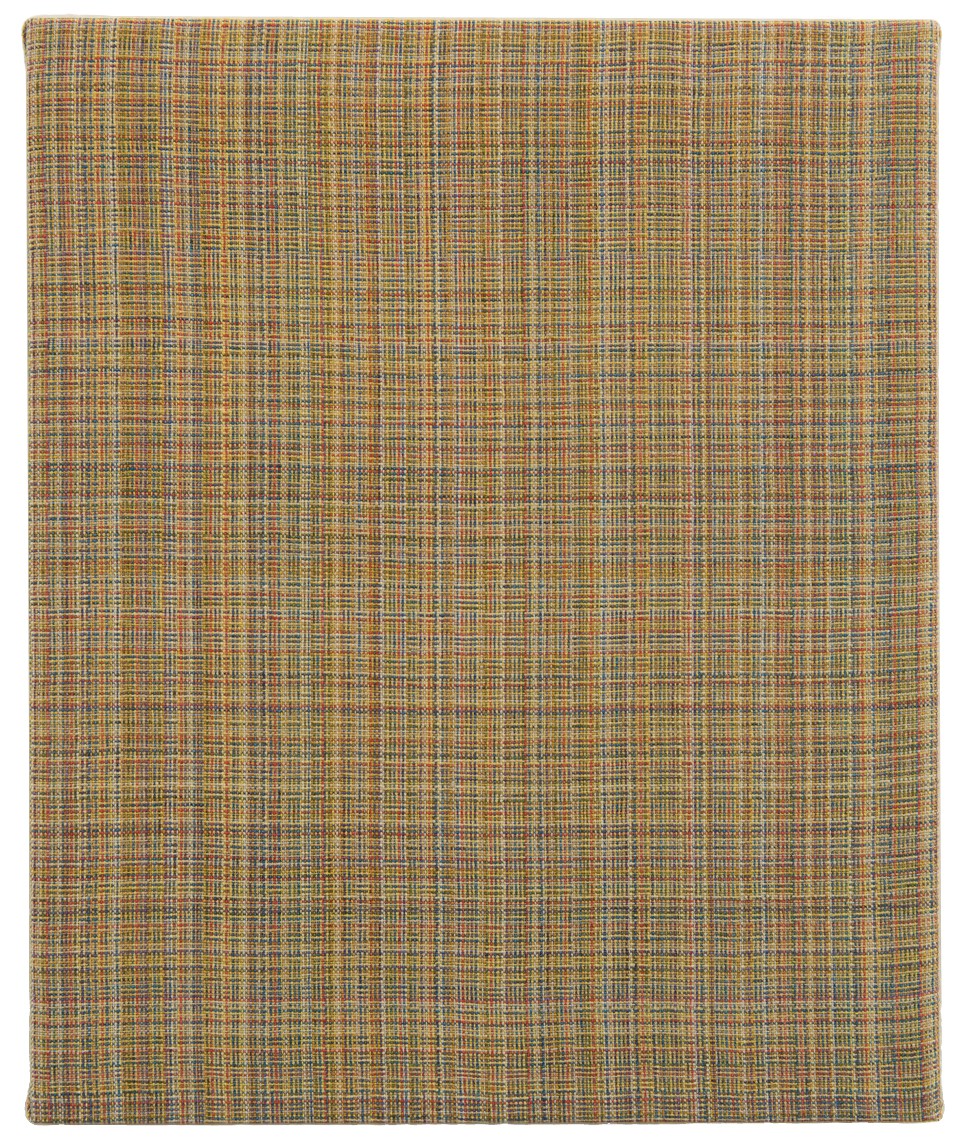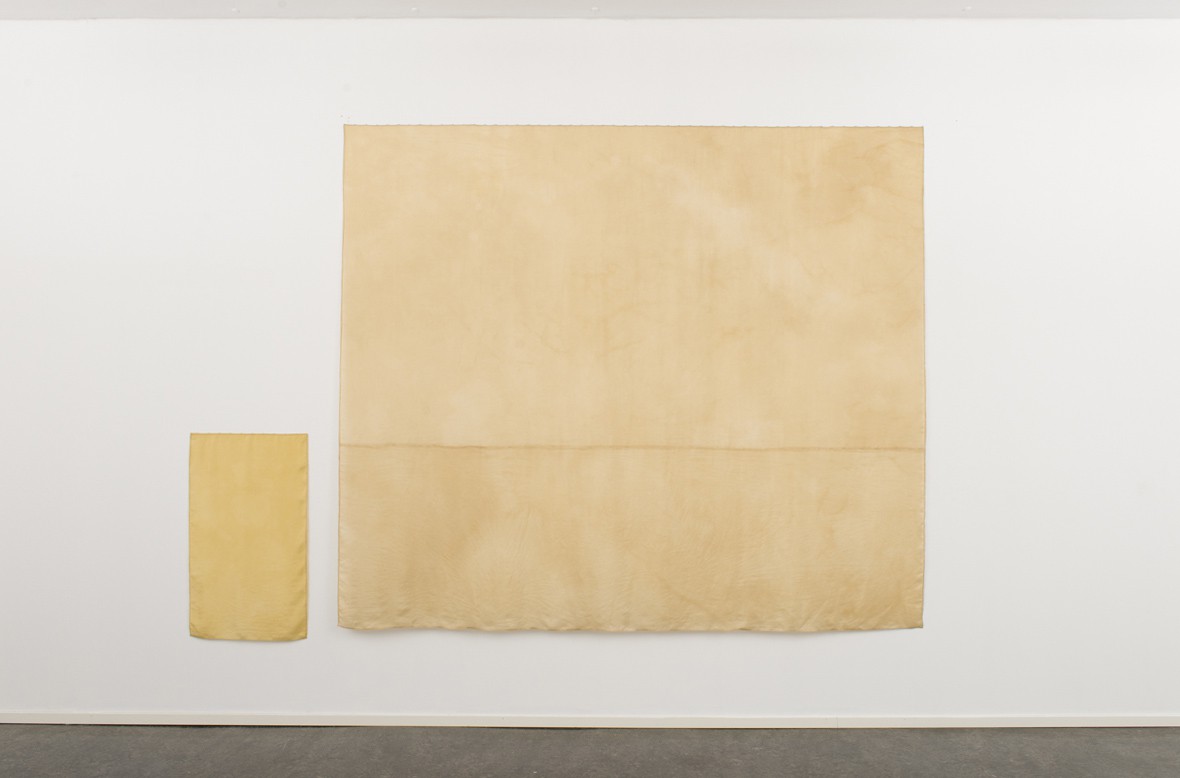Mapping a Piece of Land: Color, Material, and Earth in the Work of
Hildur Bjarnadóttir
There is something very familiar and immediate in the work of Hildur
Bjarnadóttir. Varicolored cloths, in solid colors or checked. The
texture and weave all but ask us to touch, to feel how the fabric
handles. Cut in simple shapes and arranged on the wall, the cloths all
come across as paintings. Unassuming canvasses
veiling the great concentration and thought that went into their making.
Hildur Bjarnadóttir creates her works from the ground up in an almost
literal physical sense. Her raw materials are linen and wool yarns and
silk fabric. She weaves the linen and wool and dyes the silk. In one
respect she has gone further than even the most dedicated craftspersons.
For some of her works, which may truly be called investigations given
the research and
experiment involved, she has made her own natural dyes, gathered the
plants, boiled them down, and extracted their juice as the basis of dyes
for use in coloring her yarns. It is scarcely possible to imagine
getting closer to the origin of a painting than to weave the canvas and
color it with one’s own dyes.
Hildur Bjarnadóttir gathers the material for her dyes at Þúfugarðar, her
five-acre landholding in the Flói area, east of Selfoss. She has
systematically recorded, photographed, and collected the wild plants
growing on her plot of land, such as angelica, tea-leaved willow, and
meadowsweet, and made from them the dyes used in the works displayed
here. The works in silk are dyed in extracts of single plants. The linen
and wool cloths are multicolored and woven from yarns colored partly
with herbal dyes and partly with acrylic paints. They combine natural
dyes, which Bjarnadóttir has handmade on her own land, with ready-made,
mass-produced synthetic pigments from the realm of modern technology.
From this description one might guess that the encounter of two such
different worlds would lead to dissonance and conflict. On the contrary
these colors of unlike derivation entwine to create color-tones that
easily balance and agree.
Modern art is built on a clear separation between fine arts such as
painting and sculpture and applied arts, the so-called craft and design
fields, which involve useful activities such as weaving and embroidery.
Hildur Bjarnadóttir dissolves this boundary by turning applied-art
techniques into methods of painting. These works may be termed woven
paintings, as the basic form of each is inseparable from traditional
textile methods practiced by people in Iceland and elsewhere for
centuries.
Bjarnadóttir does not begin with the empty canvas or cloth as the
starting point and ground of a painting. The ground itself has been
taken apart and put back together, as a reminder that the free, fine
arts rest on the work of those never valued at full worth, the skill and
training of craftspersons and industrial workers. Women’s crafts have
not been placed high in art´s ranks of honor.
A certain ambiguity resides in the composition of the picture surface.
The monochrome ground gains new meaning through the patterns resulting
from
different methods of weaving and crocheting threads. A multicolored
pattern of vertical and horizontal bands may be seen as either a
colorful table linen or a geometrical-abstract painting. The familiar
checked tablecloth that is sometimes allowed to peep from the
still-lifes of French Cubists or Icelandic abstract painters here takes
center-stage and assumes
independent life. The roles are reversed. We are
invited to view an abstract painting in a checked cloth, not a checked
cloth in an abstract painting.
Hildur Bjarnadóttir’s work is remarkable for the way it evokes the
complex relationship between color, material, and earth. In our modern
world natural colors live in constant close quarters with the synthetic
color-systems that surround us. Natural colors have lost ground to
synthetic colors and the endless
possibilities that technologized color-production offers. The relation
of color to material is particularly striking and strong in these woven
paintings because it has to do with their origin and meaning. These
colors manifest the earth, not the colorless world of technology but the
mortal earth we belong to.
Bjarnadóttir limits herself to organic colors, crushes the essence from
that surface of earthly flora that thrives in sunshine, and indeed her
works reveal a sympathy with the life-supporting earth that
nourishes not only vegetation but man and beast. Here color is something
more than an impression of the countryside; it is a relic of the land in
condensed and dried form.
For artists, pigments are material resources just as plaster, marble,
paper, and pencil are. In Hildur
Bjarnadóttir’s work colors are not merely material resources but
benefits of the land. Dye functions as both a visual and physical
conduit to the land where the plants grow. It maps the land with color.
This is quite removed from the view of color as a technical aspect of
executing an artwork or as a product to be chosen from a catalogue or
palette. Our age is
perhaps jaded by the glut of synthetic colors that have strayed far from
their origins and soils. If so, it rests solely in the hands of artists
to rediscover the source.
Gunnar J. Árnason
Utdanning
1994-97 Pratt Institute. MFA. New Forms Department. Brooklyn, New
York.
1989-92 The Icelandic College of Arts and Crafts. BFA. Textile
Department. Reykjavík, Iceland.
1985-89 The Commercial College of Iceland. Business and Language
Diploma. Reykjavík, Iceland.
2009 The Icelandic Arts Academy. Teaching diploma. Reykjavík Iceland.
Separatutstillinger i utvalg
2014 Subjective systems. Kunstnerforbundet. Oslo. Norway.
2014 Kortlagning lands. Hverfisgallerí. Reykjavík, Iceland.
2013 Flora of weeds. Hallgrímskirkja, church. Reykjavík. Iceland.
2011 Coherence. Hafnarborg Museum. Hafnarfjörður.
2010 Re-give. Textile Museum. Blönduós, Icland.
2008 Encircling. Pollock Gallery. Southern Methodist University. TX.
USA.
2007 Inclusion. ASÍ. Art Museum. Reykjavík, Iceland.
Textile Museum. Blöndós. Iceland.
2006 Surrogate. Safn. Reykjavík. Iceland.
Background. I8 Gallery. Reykjavík, Iceland.
Ground. The Living Art Museum. Reykjavík. Iceland.
Overlap. Pulliam Deffenbaugh Gallery. Portland, USA.
2005 Unraveled. The Boise Art Museum. Boise, ID. USA.
2004 Work(s). ASI Art Museum. Reykjavík, Iceland.
2003 Stretching Canvas. Pulliam Deffenbaugh Gallery. Portland, OR.
USA.
2002 Lassoing. Gallery Corridor. Reykjavík, Iceland.
2001 Gallery Hlemmur. Reykjavík, Iceland. 2000 Weavings and Things.
Marylhurst University. The Art Gym. Portland, OR. USA.
1998 Sýnibox. The Living Art Museum. Reykjavík, Iceland. Norsk
Kunsthandverk. The Nordic Museum of Arts and Crafts. Throndheim,
Norway.
Visibility. The Living Art Museum. Reykjavík, Iceland.
Kollektivutstillinger i utvalg
2014 Your compound view. Reykjavík Art Museum, Hafnarhúsið. Iceland.
Traces of creation. The Hafnarfjörður Center for Culture and Fine Art.
Iceland.
2013 Rakete Rinnzekete. The Nordic House. Reykjavík, Iceland.
Rakete Rinnzekete. Vestyllands Kunstmuseum, Tirstrup. Denmark.
Look at me. ASÍ Art Museum. Reykjavík, Iceland.
Elemental. Havremagasinet. Bodo, Sweeden.
2012 Carnegie Art Award Exhibition. The Royal Swedish Academy of Fine
Art. Stockhólmur, Svíþjóð.
Carnegie Art Award Exhibition. Amors Andersen Art Museum. Helsinki.
Finnland.
Carnegie Art Award Exhibition. Sophienholm. Lyngby. Kaupmannahöfn.
Danmörk.
2010 Metabolism. Reykjanes Art Museum. Reykjanes, Iceland.
Re-Give. Textile Museum. Blöndós. Iceland.
2009 Volcano Lovers. Ise Cultural Foundation. New York, NY. USA.
Þræddir Þræðir. Listasafn Árnesinga. Hveragerði. Ísland.
Cheongju International Craft Biennale. South Corea.
Dalir-hólar-handverk. Ólafsdalur, Iceland.
Minjar. Kópavogur Natural History Museum. Kópavogur, Iceland.
2008 Blurring the Line. Pulliam Deffenbaugh Gallery. Portland, OR USA.
Unusual Twist. Spencertown Art Academy. Spencertown. NY. USA.
From Another Shore: Recent Icelandic Art. Scandinavia House. New York,
NY. USA.
The Siditious Stitch. Sun Valley Center for the Arts. Sun Valley, ID.
USA.
2007 Radical Lace and Subversive Knitting. Museum of Arts and Design.
New York, NY. USA.
Thread. Koroska Gallery of Fine Arts. Slóvenía.
2006 Painting after 1980. The National Gallery. Reykjavík, Iceland.
The Visual Arts Award Exhbition. The Akureyri Art Museum. Akureyri,
Iceland.
New Embroidery. Not your Grandmothers Doily. Contemporary Crafts Museum.
Portland, OR. USA.
A Changing Fabric. Salina Art Center. Salina. KA. USA.
Women artists. I8. Reykjavík, Iceland.
2005 Volcana, Icelandic Panorama. Plug In Institute of Contemporary Art.
Winnipeg, Canada.
K-2005. Rhöda Sten. Gautaborg, Sweden.
Affair. The Jupiter Hotel. Portland, OR. USA.
2004 New Icelandic Art. The National Gallery. Reykjavík. Iceland.
Happy Art For a Sad World. Spike Gallery. NY, USA.
2003 Ulterior Motive. Marilhurst University. Portland, OR. USA.
Pins and Needles. John Michael Kohler Arts Center. Sheboygan. WI. USA.
The Wild Wild North. CityScape Community Art Space. Vancouver, BC.
Canada.
18. Women. CCC Art Cenger Gallery, Astoria, OR. USA.
2001 Contemporary Skeins. Contemporary Crafts Museum. Portland, OR.
USA.
Oregon Biennial. The Portland Art Museum. Portland, OR. USA.
Domesticity. The Waiting Room. Minneapolis, Minnesota. USA.
2000 All those if´s… Safnahúsið. Eigillstaðir. Iceland.
The Inner and Outer World - The World Above and Below. The Reykjavík Art
Museum.
Nordic Design Writers. Röhsska Museet. Göteborg, Sweden.
Flotsam und Jetsam – Strandgut. C-line Project. Kulturforum Burgkloster.
Germany.
Nonpulstra. f m schwarz galerie. Cologne, Germany.
Tweak. Mercer Union Gallery. Toronto, Canada.
Un*Domesticated. Queens Theatre in The Park. Queens, New York. USA.
Inventing Iceland. Articule. Montreal, Canada.
1999 Hot Spot. Kultur Bahnhof Eller. Dusseldorf, Germany.
Ironi. Bomuldsfabriken. Kristianssand, Norway.
Kynstrin Öll. The Reykjavík Academy. Iceland.
Chronologies. The Rotunda Gallery. Brooklyn, New York. USA.
1998 The A. I. M. Program Exhibition. The Bronx Museum of The Arts. New
York.
Representert i samlinger
1996-Present Various private collectors in Iceland, USA and Europe.
2012 The Hafnarfjörður Center for Culture and Fine Art. Iceland.
2011 The Reykjavík Art Museum. Reykjavík, Iceland.
2010 The Mint Museum. Charlotte, NC. USA.
2008 The National Gallery of Iceland. Reykjavík, Iceland.
2007 Contemporary Crafts Museum. Portland, Oregon. USA.
Tatsumi Sato Collection. Hiroshima City, Hiroshima, Japan.
Boise Art Museum. Boise, Idaho. USA.
2006 Penninn Art Collection. Iceland.
Ingunn Wernersdóttir, Art Collection. Iceland.
Drieke Zirinsky Collection. Boise, ID. USA.
2005 The National University Collection, Iceland.
The National University Hospital of Iceland.
2004 The National Gallery. Reykjavík, Iceland.
2002 Francis Greenburger Collection. New York, USA.
Art Omi. New York. USA.
2000 The Reykjavík Art Museum, Kjarvalsstaðir. Reykjavík, Iceland.



